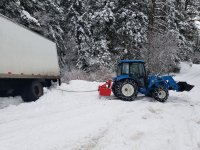Disclaimer: I have not read all of the posts in this thread. A few, but not all. Apologizes if this has been covered already.
I got my chains from tirechains.com last winter. I sprung for the duo-latter style chains with the cleats. I think, for all 4 tires + 4 spring tensionser + shipping, it was around $1500. I installed them by jacking up the tractor, moving the valve stem to the top and letting the air out. It has to be at the top, because my tires are filled with juice. Letting the air out shrinks the tire. Wrap the chains around the tire either by lifting them up (which sucks) or using the tire to spin them on (which works better, if they don't get bound up, fall off around the axle, etc.). Once they are on, hook the inside first as tight as possible. Work the chain around the tire, getting it even and well placed. Hook the outside hook and secure it as tightly as possible. Set spring tensioners, and air up the tire.
Tight chains are happy chains.
Last year, before I got chains, I got my tractor stuck on a small piece of sloped ground. The cold, hard rubber simply slid on the ice. It wasn't much of a slope, and I was in between another hill and my house. The tractor was sliding sideways toward my house!! I backed down into deep snow, worried that I might get suck there too. Put some traction sand/gravel down on the ice and was able to get out. My driveway was too the point that I could not run up it with the tractor unless I got a decent run at it. And plowing downhill, sometimes the back end would want to come around the front. My driveway is kinda steep. Those events convinced me to get chains.
I started my research here. And to be completely honest, I found much of the info lacking. I found posts of people saying not to use chains, keep them loose, etc. I was simply looking for the best chains/patterns to buy. Not if I need them. I know I need them.
I did discover though that with chains, you get what you pay for. Chains that are cheap will fall apart or break more commonly. The rounded edges on some chains allow the tire to spin easier and this causes breakage too (that's why I went with the cleats). I found that using spring tensioners will not pop off the chain as easily as bungee cords, pull better, and are a major pain to install.
With chains, I don't slide on the ice anymore. I don't spin out (not on purpose anyway), I stick like glue. They add weight and traction. I got up and down my driveway with ease. Even pull people out of the ditch on the county road when they slide off!

That image, I did get the truck out, but needed more shoveling and tugging. But I got him out. Would not have even attempted it without chains.
Check out my videos, I don't have a video of installing them, but several of me showing them and one of the removal.
